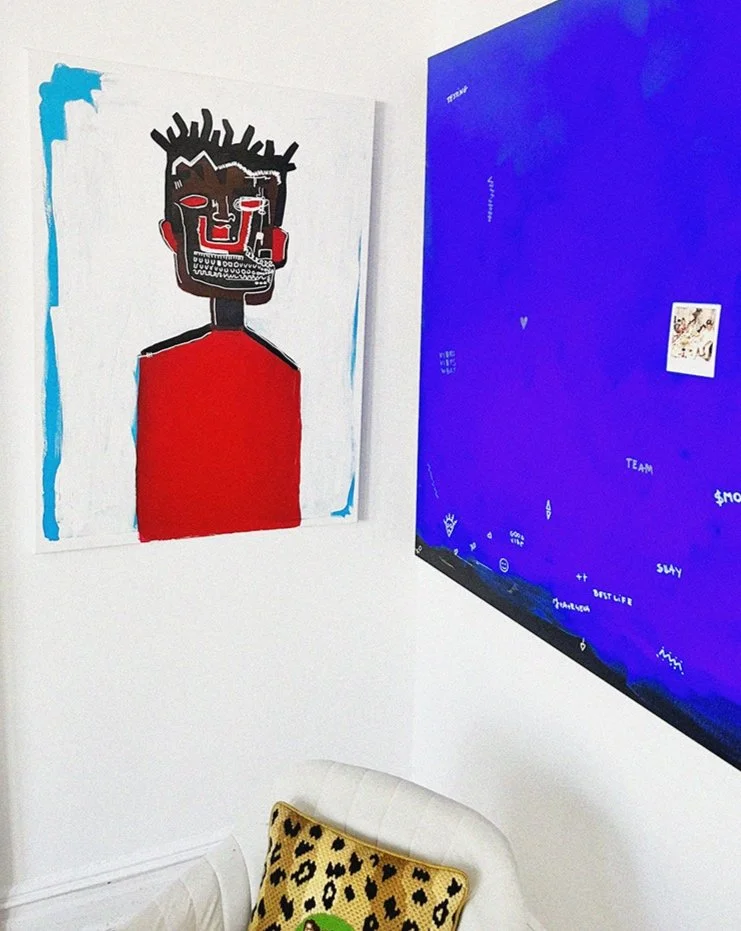My Love Letter to My Mentor, Basquiat
Baby Basquiat, 1962
Some of my most important mentors are people I've never met. They are the artists, thinkers, and visionaries whose work echoes through time, offering guidance long after they’re gone. Their lives serve as a blueprint, their art as a private masterclass.
And at the very top of that list—my mentor in spirit—is the king, the crown, the original disruptive founder: Jean-Michel Basquiat.
When I look at his work, I don’t just see an artist. I see the chaotic, brilliant, and heartbreaking story of every entrepreneur who has ever tried to build an empire out of pure, uncut vision. His canvases are pitch decks written in a language of raw urgency. Decades after his death, his ghost still haunts the mood boards of the world’s most ambitious brands. A thousand Instagram feeds try to capture a fraction of his energy—and yes, I’ve tried to emulate his style for fun, a humble bow to a mentor. But no one can truly copy him.
His story is a love letter to originality, a cautionary tale about the price of genius, and an enduring mentorship for anyone trying to leave their mark on the world.
The Legend of SAMO©: A King is Born
For those who don't know the legend, it began on the gritty streets of late-70s New York. A mysterious tag, SAMO© (for "Same Old Shit"), started appearing on downtown walls—not as simple graffiti, but as poetic, satirical bombs lobbed at the art establishment. This was Basquiat's stealth-mode startup, a viral marketing campaign for a product that was just himself.
He was a brilliant, trilingual child of Haitian and Puerto Rican heritage who, by his teens, was a charismatic force in the city's creative scene. He transitioned from street poet to art-world royalty with staggering speed, befriending his own hero, Andy Warhol, and becoming one of the most successful artists of the 20th century before he was 25. He painted on everything—canvases, doors, refrigerators—with a frantic energy, as if he had to get all the ideas out before his time was up.
And tragically, it was.
The Paradox of Genius: On Creation and Self-Destruction
It’s an agonizingly common story for creative geniuses: the same raw sensitivity that allows them to see the world differently also makes it incredibly hard to live in. The pressure of sudden fame, the weight of being a Black man in a blindingly white art world, the constant demand for more—it’s a perfect storm.
Substance abuse becomes a tempting shield for a soul that feels too much, a way to quiet the noise and keep the creative channel open. Basquiat burned brighter than anyone, but that fire consumed him. His life is a heartbreaking lesson from a mentor—a warning about the critical importance of building a support system that can protect you not just from your critics, but from yourself.
The Mentor's Blueprint: Three Basquiat Principles for Every Founder
His legacy isn't just in museums; it's a working blueprint for modern leadership. These are the lessons he taught me.
1. Authenticity is Your Only Moat.
Basquiat’s work is an unfiltered broadcast from his mind. The crossed-out words, the recurring symbols (like his iconic three-pointed crown), the fusion of anatomical drawings with critiques of colonialism—it could only have come from him. The lesson: In a business world saturated with copycats, your unique perspective is the only thing that can’t be replicated. Basquiat put a crown on his own head long before the world did. He teaches us to anoint ourselves and define our own value.
2. Your Scars Are Your Brand Story.
He didn’t hide his identity or his anger; he weaponized it. His paintings are riddled with references to Black history, jazz musicians, and the brutal realities of racism. He turned his personal and ancestral pain into a powerful, undeniable aesthetic. The lesson: Don't hide your founder story's jagged edges. A mentor like Basquiat shows that vulnerability isn't weakness; it’s the source of a brand with a heartbeat.
3. Disrupt, Don't Just Decorate.
Basquiat wasn't interested in making "pretty" art to match a sofa. He attacked the canvas. He challenged the establishment and forced a conversation. He was a punk rock innovator in a world of polite gallery openings. The lesson: He teaches us to ask, "Is my company merely decorating an existing industry, or is it fundamentally challenging it?" True market leaders don't just compete; they change the game.
My own Basquiat-ish painting at my apartment!
The Founder as Artist, The Business as Canvas
People often separate the worlds of art and business, but a mentor like Basquiat reveals them as one and the same. To be a founder is to be an artist.
You start with a terrifyingly blank canvas—a business plan. You have a vision that no one else can see. You mix your materials—capital, talent, technology—and apply them with relentless energy. You are bringing something into the world that did not exist before, fueled by nothing but will. This is the ultimate teaching from a mentor who we can only know through his work: the act of creation, whether on canvas or in a company, comes from the same place.
So thank you, Jean-Michel. For being a mentor across time. For the crowns, for the chaos, for the courage. You showed us that the most valuable commodity in the world is a singular vision, executed without compromise. Your life reminds us to burn bright, and your death reminds us to build a life that can sustain the flame.

